
NVDAX
NVIDIA tokenized stock (xStock)
| تریدر | نوع سیگنال | حد سود/ضرر | زمان انتشار | مشاهده پیام |
|---|---|---|---|---|
 DanyBoy4kالرتبة: 11 | خرید | حد سود: تعیین نشده حد ضرر: تعیین نشده | 14/11/2025 | |
 TJ01الرتبة: 160 | خرید | حد سود: تعیین نشده حد ضرر: تعیین نشده | 7/11/2025 | |
 bwyالرتبة: 57 | خرید | حد سود: تعیین نشده حد ضرر: تعیین نشده | 5/11/2025 | |
 litwizardالرتبة: 644 | خرید | حد سود: تعیین نشده حد ضرر: تعیین نشده | 7/11/2025 | |
 isahebdadiالرتبة: 1050 | خرید | حد سود: تعیین نشده حد ضرر: تعیین نشده | 4/11/2025 |
مخطط سعر NVIDIA tokenized stock (xStock)
سود ثلاثة أشهر :
سیگنالهای NVIDIA tokenized stock (xStock)
مرشح
فرز الرسالة بناءً على
نوع التاجر
الإطار الزمني
Pepperstone
وضعیت سهام انویدیا قبل از گزارش درآمد: اصلاح جزئی یا تغییر کامل بازار؟
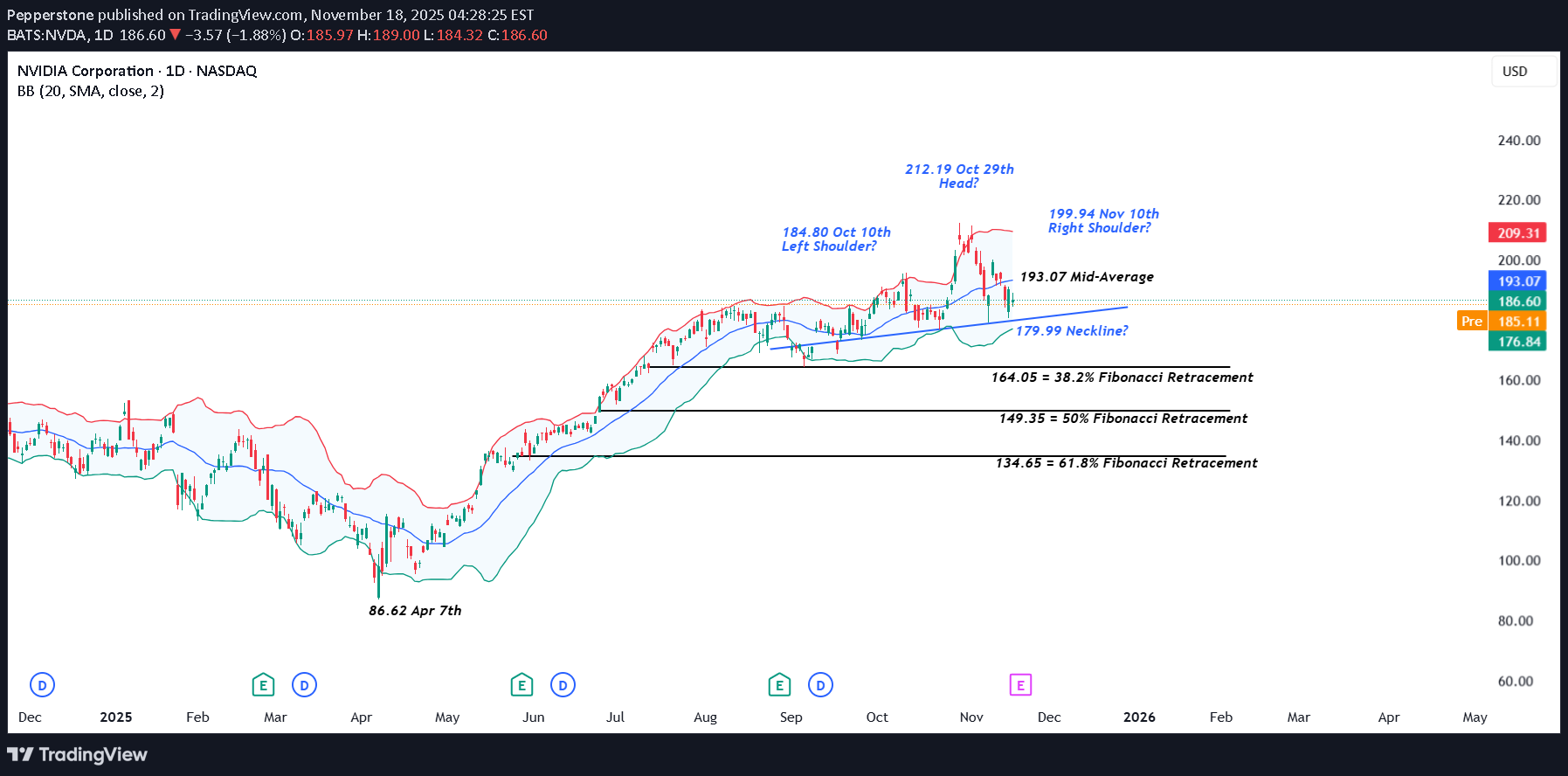
There is no getting away from it, NVIDIA’s earnings, which are due on Wednesday after the close are making traders nervous. The problem with being the largest company in the world by market capitalisation (approx.$4.53 trillion) with a roughly 7.5% weighting in the S&P 500 and closer to 10% weighting in the Nasdaq 100 is that everything related to your company matters, especially when you are seen as the global AI benchmark at a time when traders are wondering if lofty valuations given to the leading companies in the space are justified or not. Suddenly, stories like Softbank selling its entire NVIDIA stake of $5.8 billion last week, gets more headline space in the financial press and now your Q3 earnings are potentially being seen as important to the direction of market sentiment and risk appetite as whether the Federal Reserve decides to cut interest rates again at its final meeting of the year on December 10th. The earnings, when they are released are anticipated to be strong, with Reuters reporting analysts expecting an average 54% year on year rise on Q3 earnings per share. However, while traders may be judging the actual results against market expectations, they may also be keen to hear the updates from CEO Jensen Huang regarding future revenue and chips sales moving forward. With the potential for extra volatility in NVIDIA’s share price across the next 48 hours being apprised of the technical backdrop could be important. Technical Update: Limited Correction or Sentiment Shift? It has been a choppy period for the Nvidia share price since mid-September 2025, activity that has seen 3 distinct highs in price posted. As the chart below shows, these stand at 184.80 on October 10th, 212.19 from October 29th and 199.94, scored on November 10th. As you can also see on the chart, the 2nd of these 3 peaks at 212.19, is higher than the other 2, which is important from a technical perspective. This may lead some analysts to suggest this activity could be forming a potential Head and Shoulders top pattern. It is important to stress that a Head and Shoulders pattern must be completed by a close below the ‘neckline’ or the trend connecting recent price lows, which in the case of Nvidia currently stands at 179.99. Even then, completion of such a pattern isn’t a guarantee of a sentiment shift, but as we approach Nvidia earnings on Wednesday, risks may turn towards increased price volatility, and being aware of potentially relevant support and resistance levels may prove useful. [bWhat if Closes Below 179.99 Support are Seen?: Having seen recent price weakness held and reversed to the upside by the uptrend currently standing at 179.99, this could now be viewed as the first support focus. However, with it also possibly being the neckline of a potential Head and Shoulders pattern, it may prove to be pivotal moving forward. While there is no guarantee closes that below the support at 179.99 may lead to a further phase of price weakness, it might skew risks towards continued declines. Focus may then turn towards 164.05, a level equal to the 38.2% retracement level of April to October strength, possibly even towards 149.35, which is the 50% retracement. What if 179.99 Support Remains Intact?: As already said, any Head and Shoulders pattern must see closes below neckline support to suggest a completion and risks for further price declines. For Nvidia the 179.99 support is still intact on a closing basis, and it could be argued this is not yet a valid reversal pattern. As such, while the 179.99 level holds, traders may view recent price declines as a limited correction within what could still be classed as an uptrend in price. However, if a further phase of price strength is to materialise, traders may require closes back above the still rising Bollinger mid-average currently at 193.07. Such moves if seen, could then lead to tests of 199.94 the November 10th high, even on towards 212.19, the October 29th extreme. The material provided here has not been prepared accordance with legal requirements designed to promote the independence of investment research and as such is considered to be a marketing communication. Whilst it is not subject to any prohibition on dealing ahead of the dissemination of investment research, we will not seek to take any advantage before providing it to our clients. Pepperstone doesn’t represent that the material provided here is accurate, current or complete, and therefore shouldn’t be relied upon as such. The information, whether from a third party or not, isn’t to be considered as a recommendation; or an offer to buy or sell; or the solicitation of an offer to buy or sell any security, financial product or instrument; or to participate in any particular trading strategy. It does not take into account readers’ financial situation or investment objectives. We advise any readers of this content to seek their own advice. Without the approval of Pepperstone, reproduction or redistribution of this information isn’t permitted.
عملکرد سهام انویدیا (NVDA) قبل و بعد از اعلام گزارشهای مالی: آمار و ارقام کلیدی
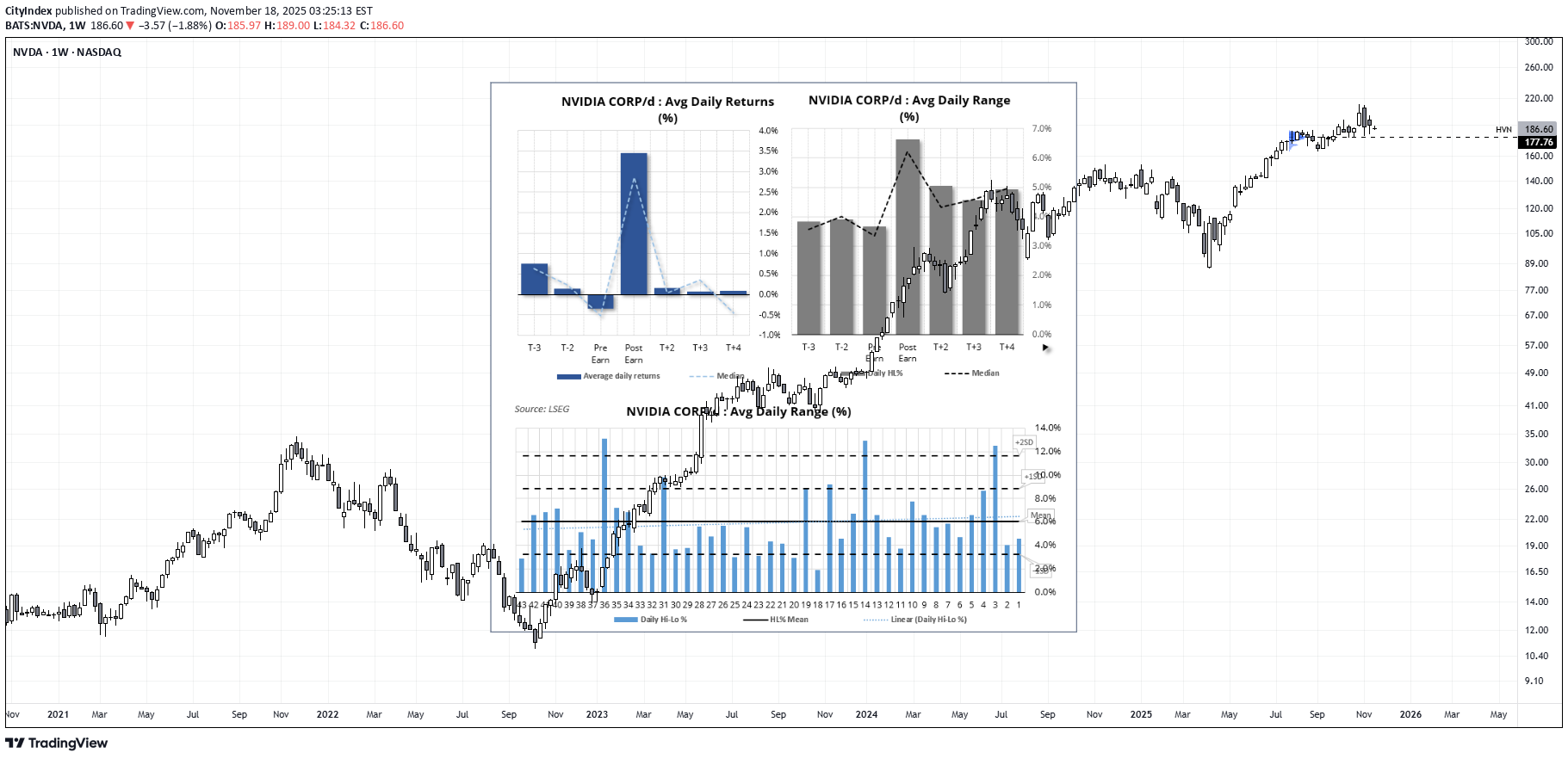
مع استعداد Nvidia لإعلان أرباحها بعد إغلاق الولایات المتحدة یوم الأربعاء، ألقی نظرة على حرکة الأسعار الأخیرة حول التقاریر السابقة، ومخطط Nvidia ومؤشر Nasdaq. مات سیمبسون، محلل السوق فی City Index.

SwingTraderPhilTV
هشدار بزرگ: انویدیا در آستانه سقوط 25 درصدی! آیا زمان فروش (شورت) فرا رسیده است؟
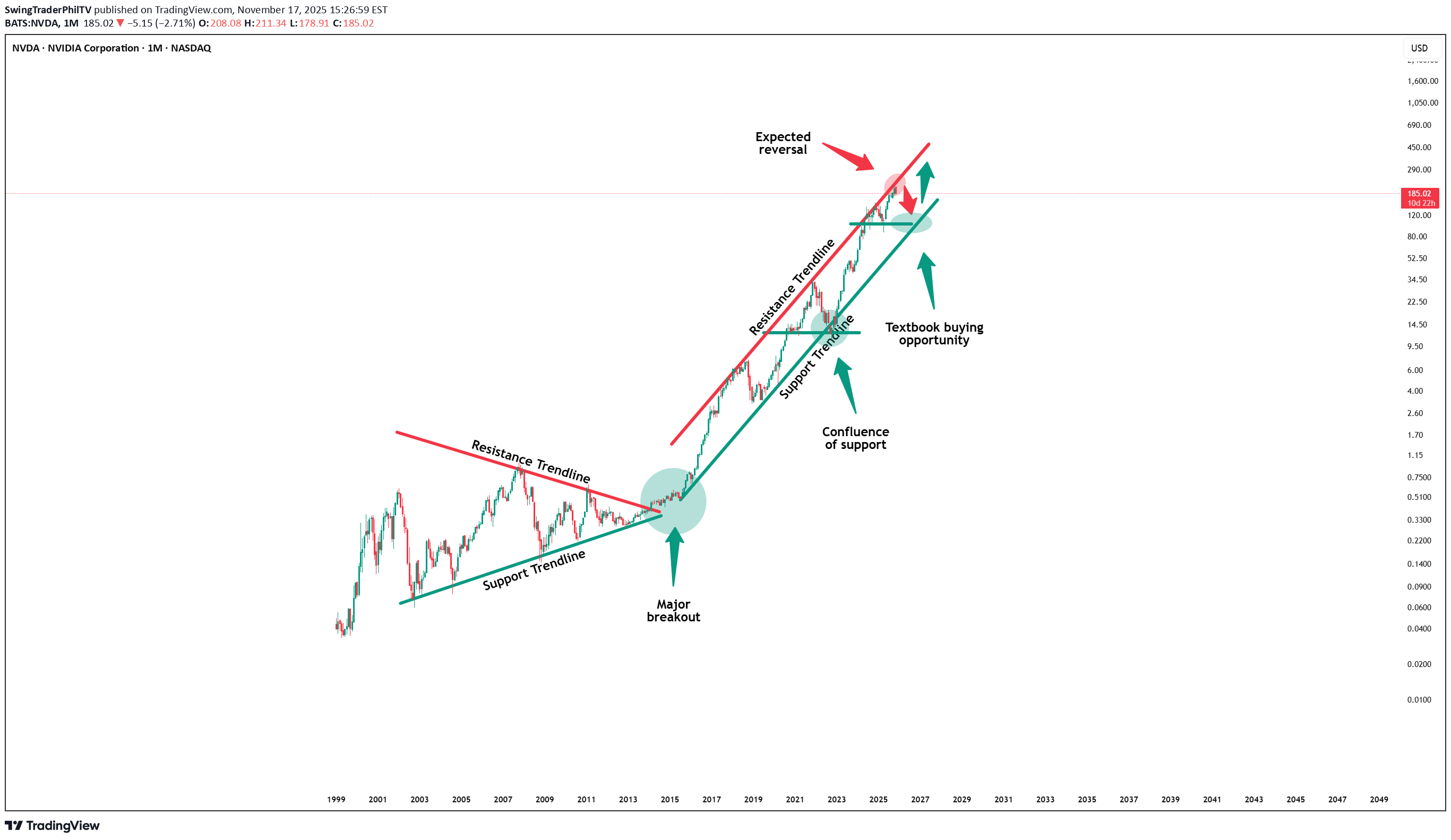
💣 نفیدیا ( NVDA ) یقوم الآن بإنشاء قمة: 🔎ملخص التحلیل: منذ بضعة أیام فقط، أعادت Nvidia اختبار خط اتجاه المقاومة major بشکل مثالی. دائماً فی الماضی، مثل هذا الاختبار یتبعه major move نحو الأسفل. لذلک، تستعد Nvidia لانخفاض major، مما قد یؤدی إلى انخفاض آخر بنسبة -25% فی المستقبل. 📝مستویات للمشاهدة: 180 دولارًا و 140 دولارًا و 100 دولارًا سوینغترادرفیل SwingTrading.Simplified. | الاستثمار.مبسط. | #رؤیة طویلة الأمد

quantsignals
سیگنال فروش پنهان برای انویدیا (NVDA): آیا خریداران کم آوردند؟
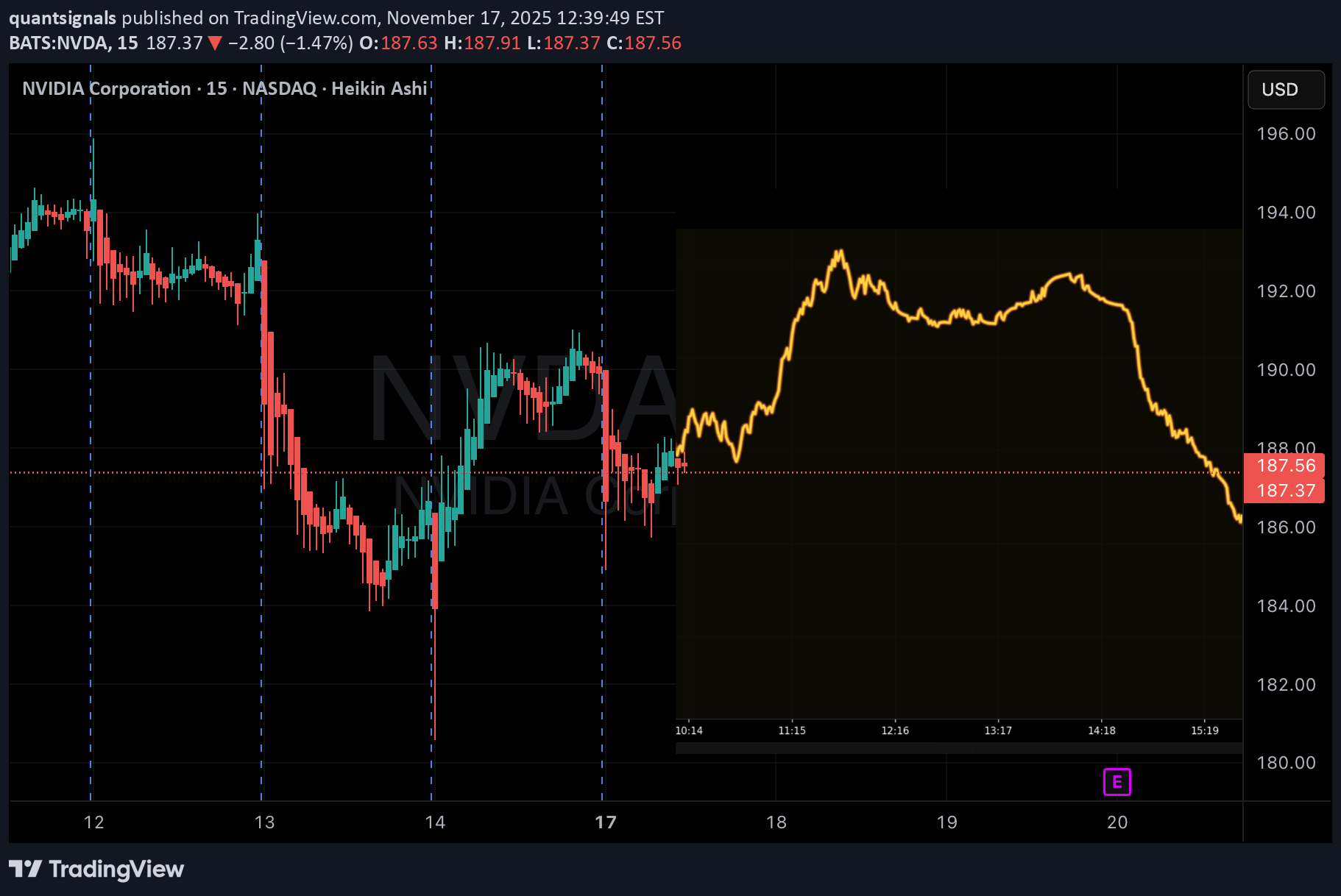
NVDA (QuantSignals V3) هیکل السوق: یُظهر NVDA زخمًا محایدًا إلى ضعیفًا مع تأرجح السعر بالقرب من المقاومة قصیرة المدى عند 189-190 دولارًا. یفقد المشترون قوتهم، ویظهر الشریط تشکیلات مرتفعة منخفضة، مما یشیر إلى الإرهاق المحتمل. توقعات الاتجاه: یشیر نموذج Katy 1M إلى الضغط السلبی الناعم. على الرغم من قراءة الاتجاه المحایدة، یمیل الهیکل اللحظی نحو التراجع المسیطر علیه، مدعومًا بتقلبات معتدلة (16.5٪). طلب Flow البصیرة: یبدو أن الزخم flow یتباطأ، مع انخفاض الحجم الصعودی. یشیر الاتجاه الجزئی إلى سلوک التلاشی، حیث قد یتم بیع التجمعات الصغیرة. المستویات الرئیسیة: المقاومة: 189.40 دولارًا / 191.70 دولارًا الدعم: 188.00 دولارًا / 186.80 دولارًا منطقة الزناد القصیرة: 188.50 دولارًا - 189.00 دولارًا Vision ملخص: یُظهر NVDA زخمًا أقل، وإقناعًا ضعیفًا للمشتری، وتحولًا جزئیًا قصیر التحیز. یتوافق الإعداد الأفضل مع فروة الرأس القصیرة الضیقة التی تستهدف جیب السیولة التالی تحت 188.00 دولارًا.

FXTraderPaul
گزارش درآمد انویدیا (NVDA): آیا این هفته سهم به اوج میرسد یا سقوط میکند؟
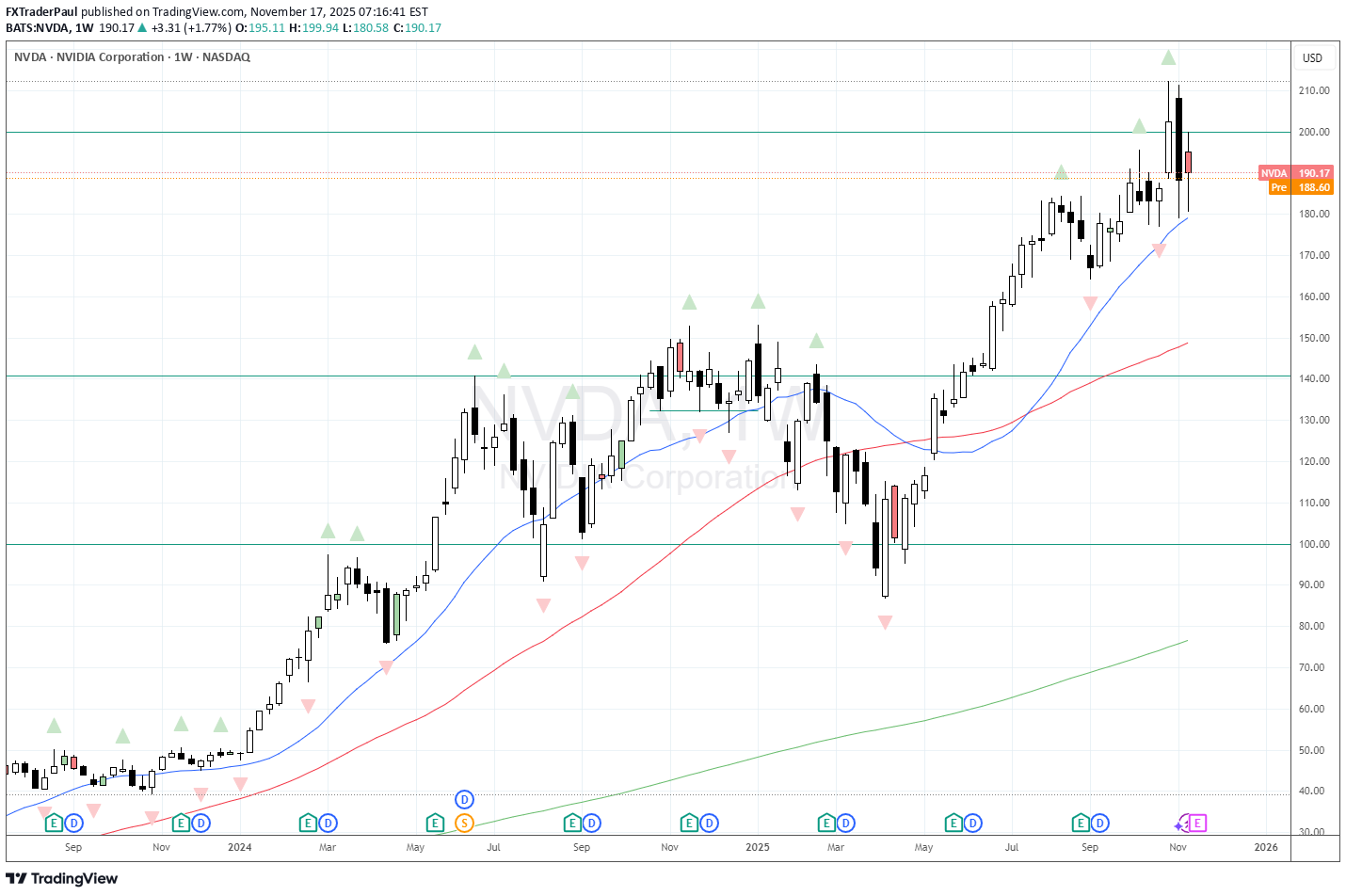
لقد مرت بضعة أشهر أخرى من التحرکات الصعودیة الکبیرة على NVDA، ولکن الأسبوعین الماضیین کانا متقلبین. لقد رفضنا مستوى 200 دولار ووجدنا أنفسنا الآن جالسین فوق 180 دولارًا ومتوسط 20MA الأسبوعی. إذا کانت الأرقام جیدة فأنا متأکد من أن الدوار سیأخذنا إلى مستوى أعلى. إذا کانت الأرقام ضعیفة، فیجب علیک أن تسأل هل سیکون 180 دولارًا و 20MA الأسبوعی act بمثابة دعم، أم أنها سوف تنهار؟ وإذا فعلوا ذلک، فماذا سیحدث للتکنولوجیا والأسواق الأمریکیة بشکل عام؟ هذا یعنی أنه سیکون أسبوعًا مثیرًا للاهتمام!
پیشبینی حرکت قیمت انویدیا (NVDA) پیش از اعلام نتایج: تحلیل تکنیکال و انتظارات بازار
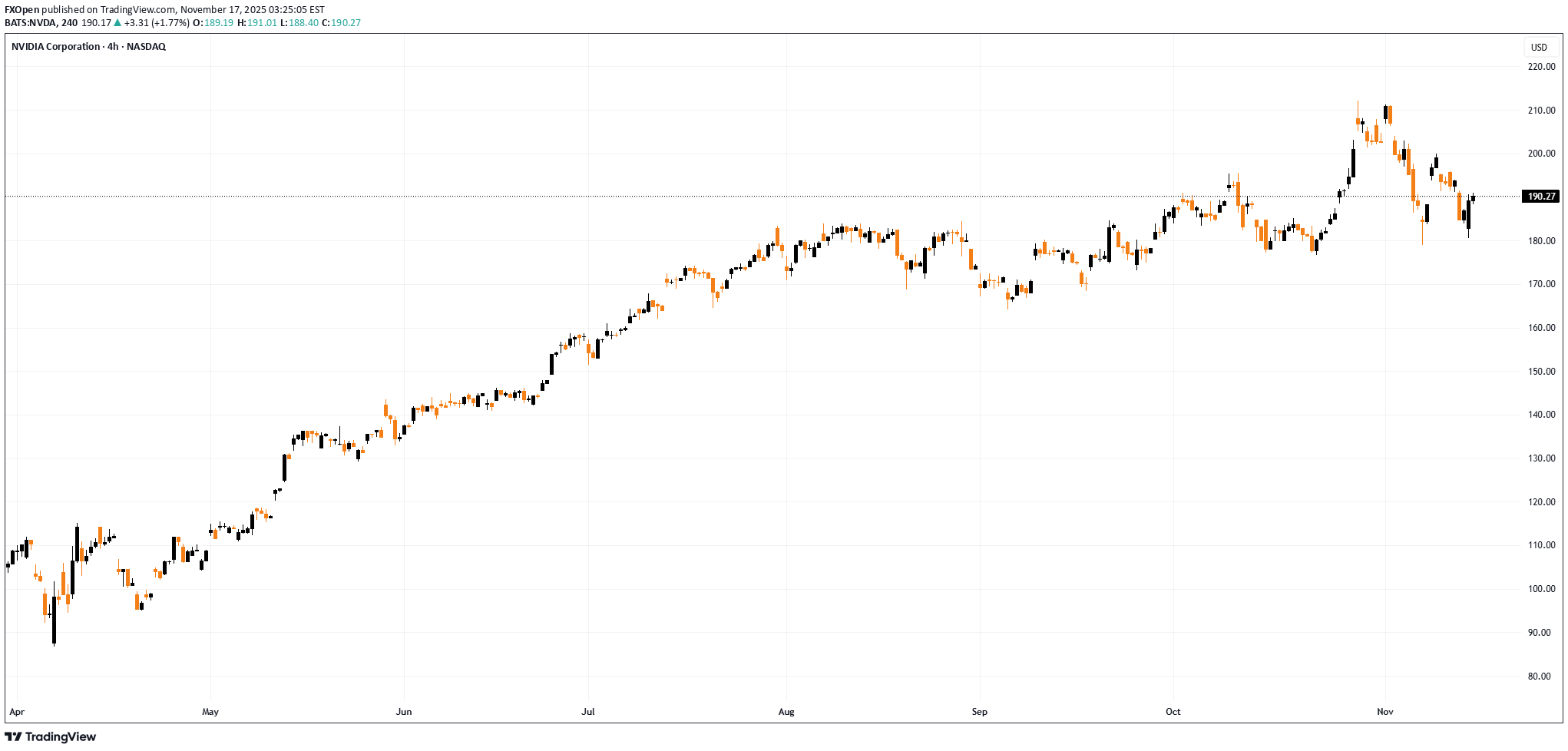
قبل أرباح Nvidia (NVDA): کیف یمکن للسعر Move یوم الأربعاء، بعد اختتام جلسة التداول الرئیسیة فی الولایات المتحدة، ستصدر شرکة Nvidia نتائجها الفصلیة - وهو تقریر لا یُنظر إلیه على أنه مجرد دفعة أخرى من الشرکات data ولکن کاختبار حاسم للمسار الصعودی الذی یقوده الذکاء الاصطناعی بأکمله. ارتفعت أسهم NVDA بأکثر من 40% منذ بدایة العام، ویجب على الشرکة الآن prove أن یکون هذا الارتفاع مبررًا وأن الثورة AI لا تزال تتسارع. وفقًا لتقاریر وسائل الإعلام، لا یزال محللو وول ستریت متفائلین: → الإیرادات: من المتوقع أن تبلغ حوالی 54.9 ملیار دولار، مما یعنی نموًا بنسبة 56٪ تقریبًا على أساس سنوی. → ربحیة السهم (EPS): حوالی 1.25 دولار (الربع السابق: 1.05 دولار). ما الذی یجب أن یرکز علیه المستثمرون؟ ستکون ذات أهمیة خاصة: → data على Data إیرادات المرکز، وهو مؤشر رئیسی لمعرفة ما إذا کانت الطفرة AI لا تزال سلیمة؛ → التوجیه المستقبلی، حیث یبحث السوق عن الطمأنینة بأن شرکات التکنولوجیا الکبرى ستستمر فی الإنفاق بکثافة على AI. التحلیل الفنی لمخطط Nvidia (NVDA). تشیر حرکة السعر الأخیرة فی NVDA إلى تسلسل یمکن تفسیره على أنه هبوطی: ← 28 أکتوبر: ارتفاع قوی فوق المستوى النفسی 200 دولار؛ ← الفشل فی الصمود فوق هذا الحاجز؛ → تراجع فی أحجام التداول المرتفعة (ناسداک data) مع توسع الشموع فی أوائل نوفمبر. فی سیاق السوق الأوسع، من الجدیر بالذکر أن أوائل نوفمبر شهد أداء NVDA أقل من 10> من مؤشرات الأسهم، مما یشیر إلى مقاومة قویة من البائعین حول 200 دولار. من منظور صعودی، فإن الانخفاض من أعلى مستوى على الإطلاق یشبه نمط التصحیح (کما هو موضح فی red) ضمن اتجاه صعودی أکبر. ومع ذلک، هناک خطر ألا یتم تلبیة توقعات السوق العالیة عند نشر تقریر الأرباح. إذا حدث ذلک، فقد یوسع NVDA تراجعه نحو الحد الأدنى للقناة الصاعدة، حیث یقع الدعم بالقرب من 165 دولارًا. یمثل هذا المقال رأی الشرکات العاملة تحت العلامة التجاریة FXOpen فقط. لا ینبغی تفسیره على أنه عرض أو التماس أو توصیة فیما یتعلق بالمنتجات والخدمات التی تقدمها الشرکات العاملة تحت العلامة التجاریة FXOpen، ولا ینبغی اعتباره نصیحة مالیة.

BullBearInsights
آیا انویدیا (NVDA) پس از ریزش سنگین، تثبیت شد؟ تحلیل سطوح حیاتی و رازهای پشت جهش قیمت
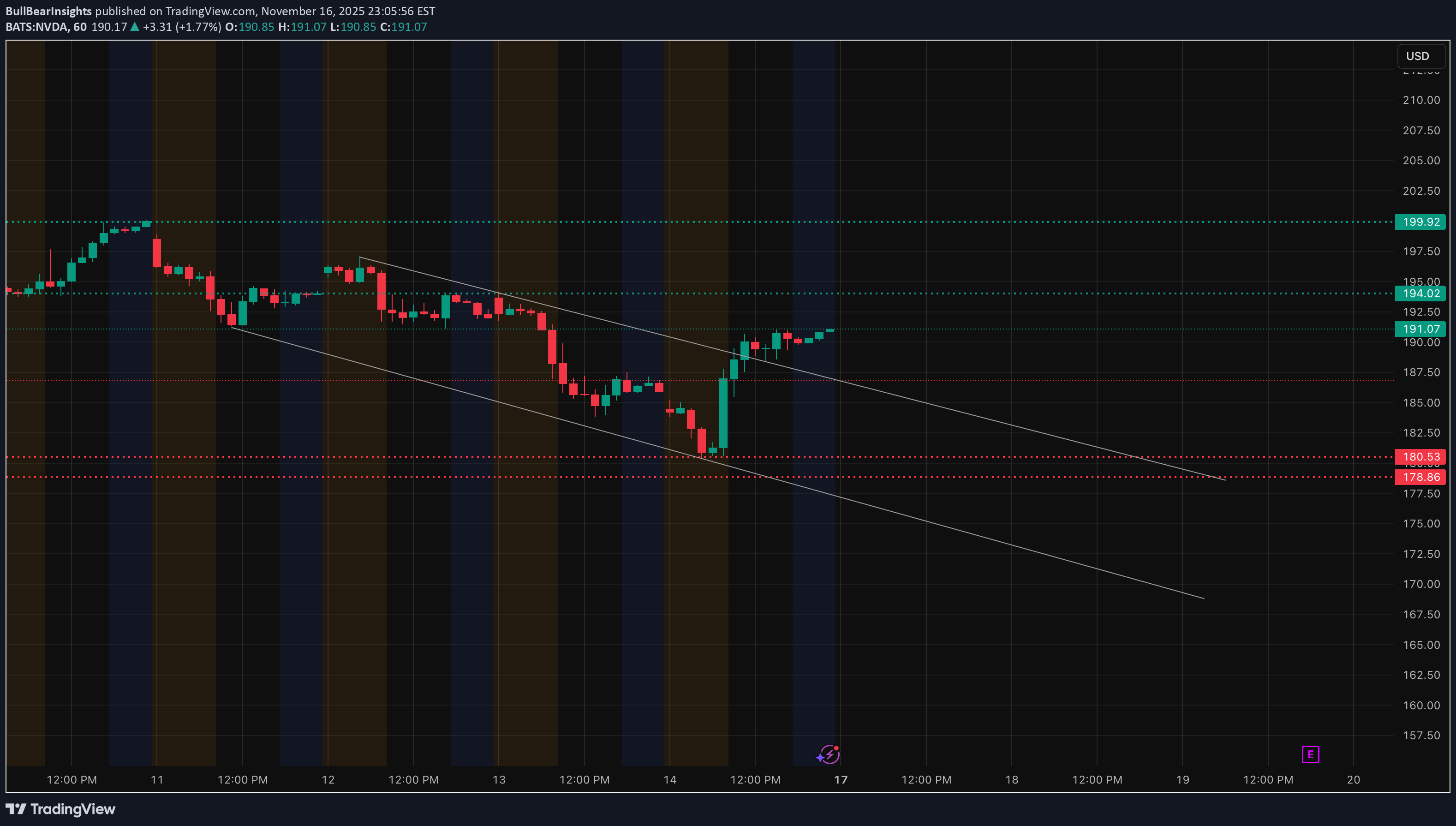
أظهر NVDA أخیرًا أول إشارة حقیقیة للاستقرار بعد عدة أیام من البیع الخاضع للمراقبة. لم یکن الـ move من القیعان عشوائیًا - فعندما تقوم بتکبیر الأطر الزمنیة المختلفة ودمجها مع مشهد GEX، فإن الارتداد فی الواقع یبدو منطقیًا للغایة. هبط NVDA مباشرة إلى منطقة البیع deep، ووصل إلى القاع، ثم صعد عائدًا عمدًا. دعونا نحلل ما یحدث بالفعل هنا. 1️⃣ رسم بیانی مدته ساعة واحدة - اتجاه هبوطی، ولکن المشترین صعدوا أخیرًا یظهر الرسم البیانی للساعة الواحدة أن NVDA یکسر کل مستویات الدعم الثانویة لعدة أیام، وینزلق بسلاسة إلى أسفل القناة الهابطة. ولم یهدأ ضغط البیع إلا عندما لامس السعر منطقة 178-181. هذا هو المکان الذی التقى فیه دعم خط الاتجاه بجیوب السیولة السابقة، وکان رد فعل المشترین على الفور. والأمر الملحوظ هو مدى سرعة تعافی NVDA مرة أخرى نحو 190. وهذا یخبرنی بأمرین: 1. غطى البائعون بقوة عند القاع. 2. کان المشترون ینتظرون الاقتراب من خط الاتجاه هذا. مستویات 1H الهامة: * 190-192: اختبار المقاومة الأول * 194–195: المنطقة الحرجة لم یتمکن NVDA من استعادتها فی المرة السابقة * 199-202: مقاومة أکبر إذا اتسع الزخم * 178-181: منطقة الطلب القویة التی بدأت الارتداد یُظهر الرسم البیانی 1H التحول الأول من "الأسفل المستقیم" إلى "الارتداد المتحکم فیه". 2️⃣ رسم بیانی مدته 15 دقیقة — یتحرک الزخم نحو الأعلى، لکنه یحتاج إلى تأکید یظهر الرسم البیانی 15M أن NVDA یستعید العدید من خطوط FVG الصعودیة الصغیرة فی طریقه للأعلى. الجزء الأکثر أهمیة هو کیفیة تعامل NVDA مع عملیات التراجع خلال الیوم - حیث کان کل انخفاض سطحیًا وتم شراؤه بسرعة. هذا ما یبدو علیه سلوک الانعکاس المبکر. الأشیاء الرئیسیة التی أراها فی الیوم 15M: * تتشکل FVG الصاعدة تحت السعر ← یمتص المشترون الانخفاضات * مقاومة المدى القصیر عند 191-192 ← السعر متردد هنا * استعادة خط الاتجاه یمنح NVDA مجالًا لإجراء اختبارات أعلى لا یؤکد الرقم 15M وجود اتجاه صعودی قوی حتى الآن، ولکنه یظهر تحولًا واضحًا فی الشخصیة من سیطرة البائعین إلى المشترین على الأقل المتنافسین. 3️⃣ GEX (ساعة واحدة) — یشرح بالضبط سبب وصول NVDA إلى القاع حیث وصل هذا هو الجزء الذی یربط move بأکمله معًا. ارتد NVDA بالضبط عند جدار PUT deep عند مستوى 178-181 تقریبًا، حیث یرتفع ضغط التحوط. ولهذا السبب کان الانعکاس حادًا جدًا. مستویات جاما الصاعدة *191:سحبة GEX الأولى * 194-195: مجموعة GEX الثقیلة * 200-203: جدار الاتصال الثانی * 210: GEX10 کبیر + جدار اتصال ثالث إذا تمکن NVDA من استعادة 194-195، فإن الاتجاه move نحو 200-203 یصبح أسهل بکثیر مما یبدو على المخطط وحده. مستویات غاما السلبیة * 182: المنطقة المحوریة * 178: جدار البیع الرئیسی — المستوى المحدد الذی أوقف البیع * 175–170: یتم تفعیله فقط إذا خسر NVDA 178 بشکل حاسم هیکل GEX نظیف: * یفقد البائعون قوتهم فوق 192 * یفقد المشترون السیطرة تحت 182 * منطقة المعرکة الحقیقیة تقع بین 188-192 هذا هو نوع خرائط GEX الذی یجعل المتداولین یتساءلون: "لماذا یرتد NVDA أو یتوقف دائمًا عند نفس المستویات الغریبة؟" (ونعم - GEX یعطی الجواب.) 🎯 کیف أتداول مع NVDA لیوم 17/11 🔼 السیناریو الصاعد (یفضل فقط فوق 192) یحتاج NVDA إلى مسح 192 بقوة. إذا حدث ذلک: فکرة تداول الأسهم: * الدخول: 192.20-192.50 * الأهداف: * 194 * 195 * 198 * 200–203 (منطقة جدار الاتصال) فکرة الخیارات: * 195 درجة مئویة أو 200 درجة مئویة * تداول قائم على الزخم إذا استعاد NVDA 192 بحجم تداول * مقیاس فی کل منطقة GEX هذا هو أنظف الإعداد. 🔽 السیناریو الهبوطی (صالح فقط إذا رفض NVDA 192 أو خسر 182) الإدخال رقم 1 (عدوانی): * یرفض 192 → اختصار إلى 188 الإدخال رقم 2 (تأکید أقوى): * کسر تحت 182 الأهداف: * 180 * 178 (جدار وضع قوی) * 175 (فی حالة ارتفاع التقلبات) فکرة الخیارات: * 185P للتحرکات السریعة * 180P للمتابعة * تحت 178 → تسارع الاتجاه الهبوطی بشکل حاد ⚠️ منطقة التقطیع: 188-191 هذه هی منطقة التوازن التی من المحتمل أن یتوقف فیها NVDA مؤقتًا ویتظاهر ویحاصر کلا الجانبین. من الأفضل تجنبه إلا إذا کنت تقوم بسلخ فروة الرأس بمخاطر شدیدة. الأفکار النهائیة نجح NVDA أخیرًا فی الحصول على عرض حقیقی بعد سلسلة طویلة من الارتفاعات المنخفضة والانخفاضات المنخفضة. لم یکن الارتداد عرضیًا - فهو یتماشى مع جدران وضع GEX وخط الاتجاه الهیکلی deep. یقع NVDA الآن أسفل مستوى المقاومة الرئیسی عند 192. هذا هو الخط الذی یقرر ما إذا کان هذا سیتحول إلى انعکاس حقیقی أم مجرد قمة منخفضة أخرى داخل الاتجاه الهبوطی. فوق 192 ← یفتح الرسم البیانی بشکل جمیل. أقل من 182 → یستعید الدببة السیطرة. أی شیء بینهما هو الضوضاء. إخلاء المسؤولیة هذا التحلیل للأغراض التعلیمیة فقط ولا یشکل نصیحة مالیة. قم بالتداول دائمًا مع إدارة المخاطر المناسبة.

Serana2324
تحلیل تکنیکال NVDA: آیا قیمت به حمایت مهم 167-155 دلار میرسد؟
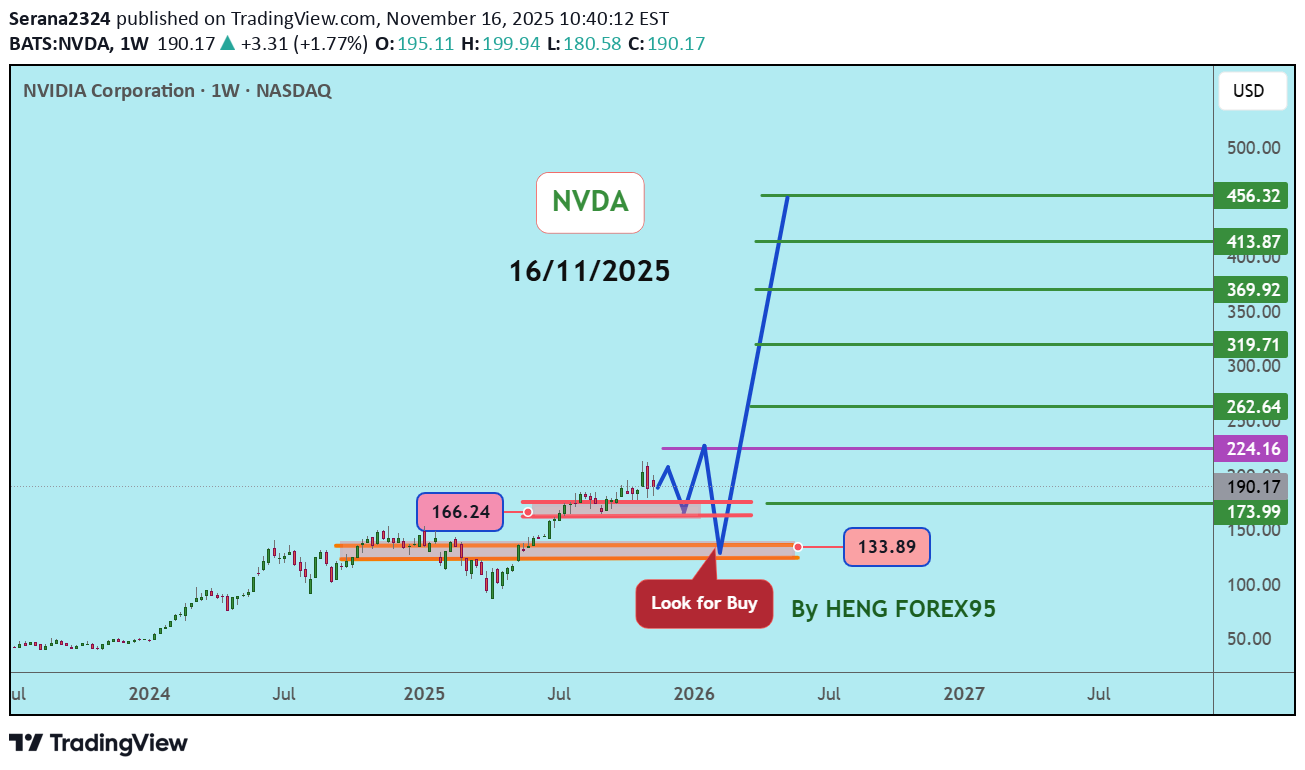
لا تزال NVIDIA فی اتجاه صعودی. فی الأسبوع الماضی، وصل السعر إلى مستوى مرتفع جدید عند 210 دولارات، لکن السعر لم یتمکن من اختراق هذا المستوى، لذلک تم تعدیله للأسفل. من المتوقع أن یختبر السعر على الأرجح منطقة الدعم المهمة عند 167-155 دولارًا. إذا لم یتمکن السعر من اختراق مستوى 155 دولارًا، فلا یزال لدى السعر فرصة للارتفاع. ومع ذلک، إذا استمر السعر فی الارتفاع فی المستقبل القریب، فقد یحدث تصحیح أیضًا. خطة تداول طویلة المدى: انتظر حتى یکتمل التصحیح قبل الشراء. ** هذه لیست نصیحة مالیة. 🔥تداول العقود الآجلة والعملات الأجنبیة والعقود مقابل الفروقات والأسهم ینطوی على مخاطر الخسارة. یرجى النظر بعنایة فیما إذا کان هذا التداول مناسبًا لک. >> بالتوفیق 😊 ❤️ لایک واشترک حتى لا تفوت أی فکرة جدیدة!

iamzr
نتیجه گزارش انویدیا (NVDA) چه میشود؟ پیشبینی غیرمنتظره برای شاخص نزدک ۱۰۰
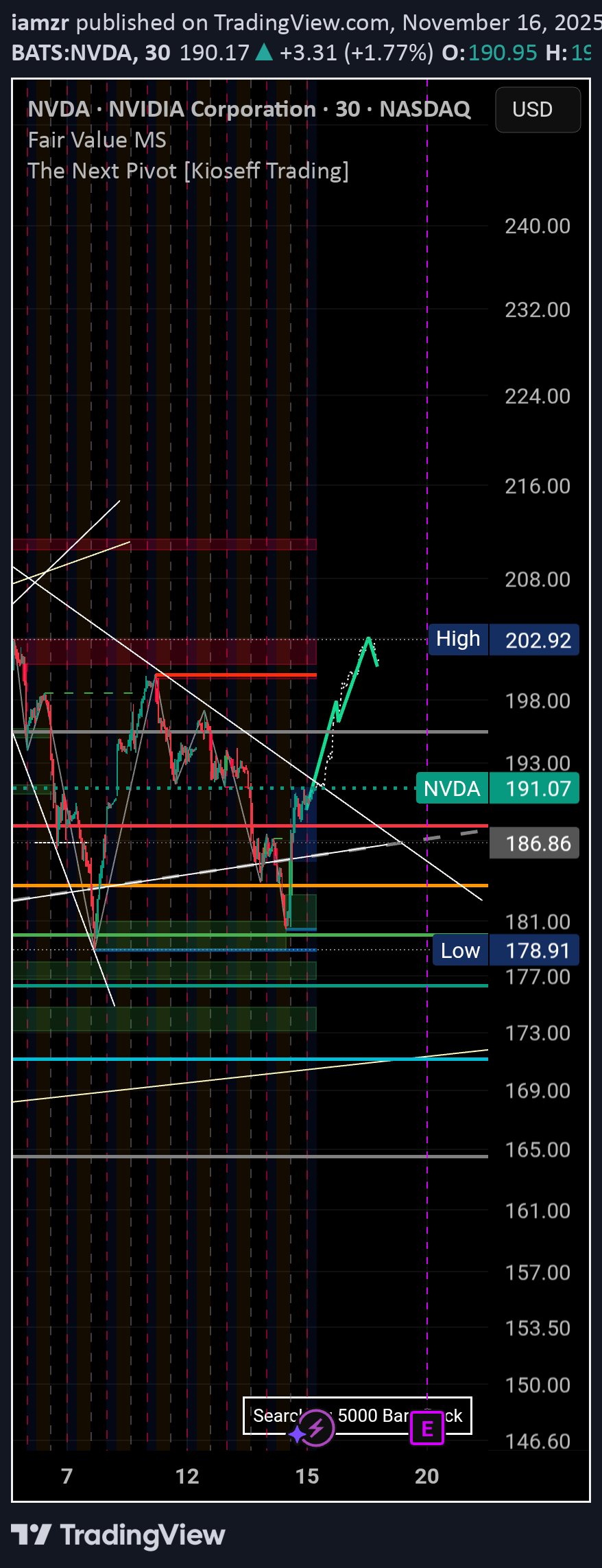
أرباح #nvda لن تکون کما هو متوقع ولکن لا داعی للحذر

Bfinance-2025
انفجار انویدیا (NVDA) در گزارش مالی: آیا این آخرین جهش بزرگ قبل از ریزش است؟
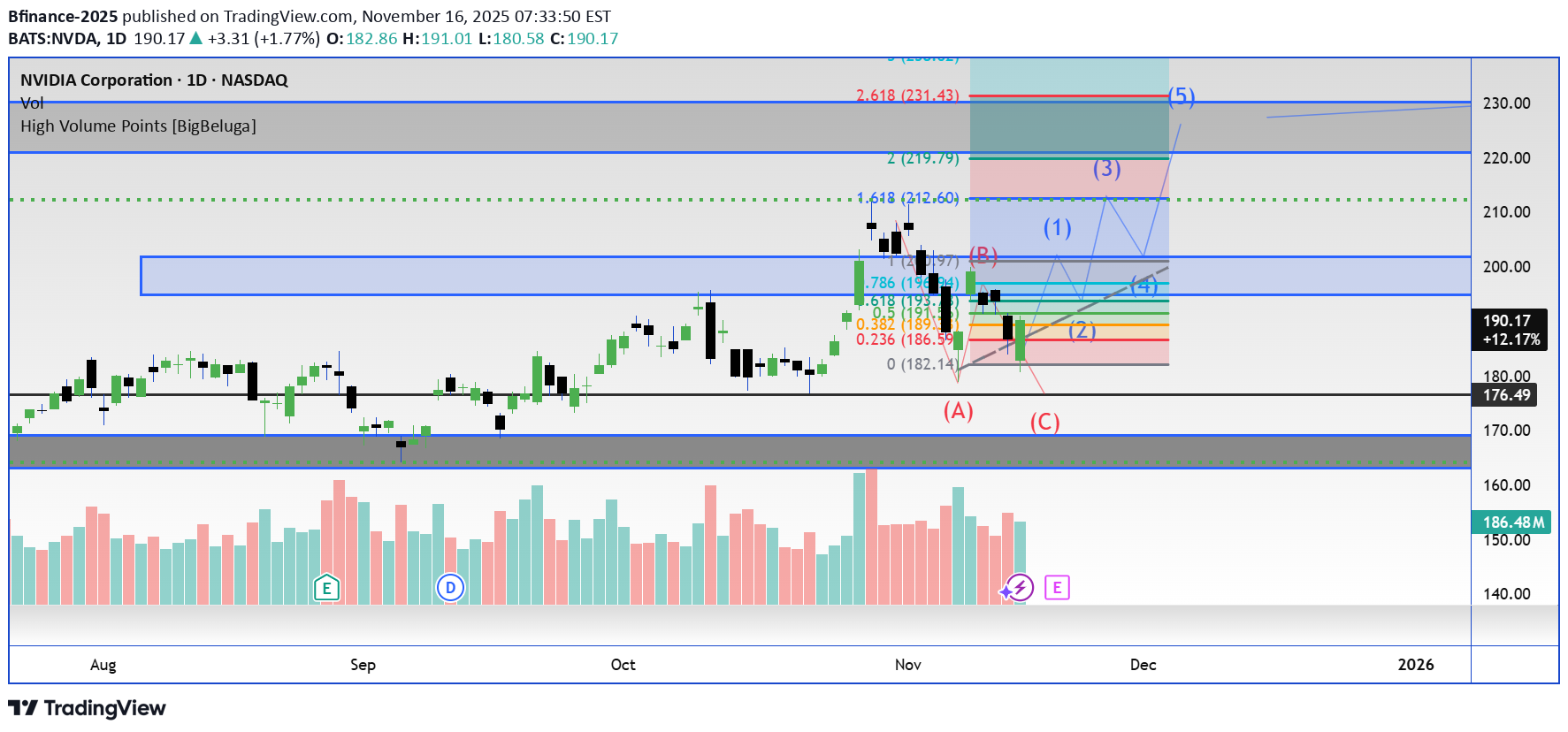
إخلاء المسؤولية
أي محتوى ومواد مدرجة في موقع Sahmeto وقنوات الاتصال الرسمية هي عبارة عن تجميع للآراء والتحليلات الشخصية وغير ملزمة. لا تشكل أي توصية للشراء أو البيع أو الدخول أو الخروج من سوق الأوراق المالية وسوق العملات المشفرة. كما أن جميع الأخبار والتحليلات المدرجة في الموقع والقنوات هي مجرد معلومات منشورة من مصادر رسمية وغير رسمية محلية وأجنبية، ومن الواضح أن مستخدمي المحتوى المذكور مسؤولون عن متابعة وضمان أصالة ودقة المواد. لذلك، مع إخلاء المسؤولية، يُعلن أن المسؤولية عن أي اتخاذ قرار وإجراء وأي ربح وخسارة محتملة في سوق رأس المال وسوق العملات المشفرة تقع على عاتق المتداول.
